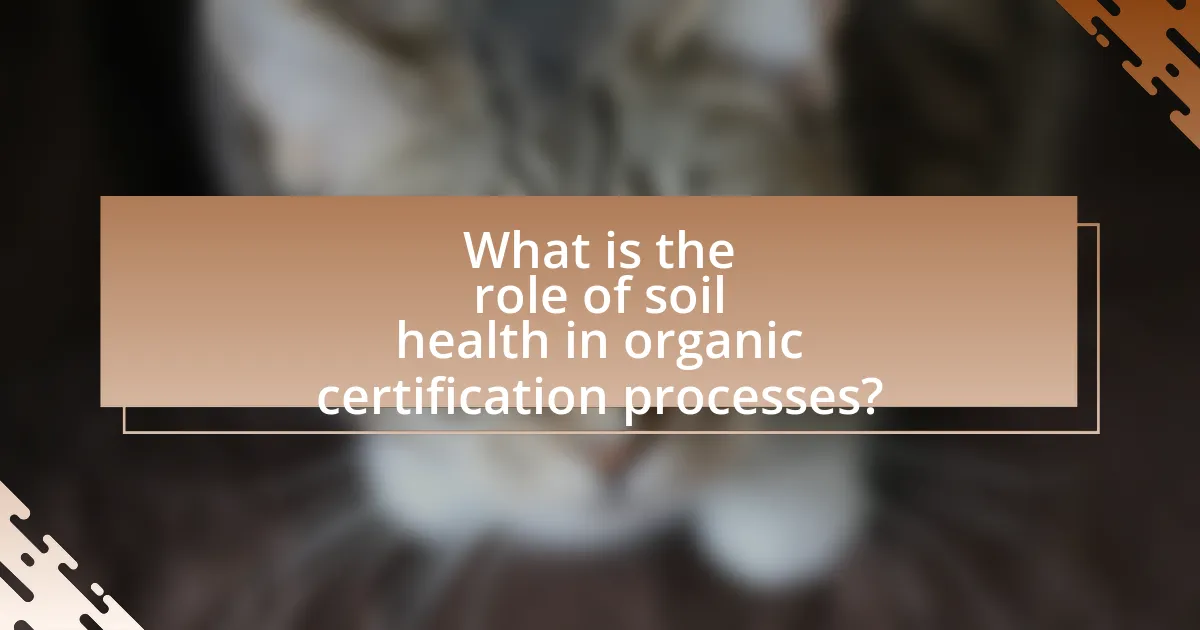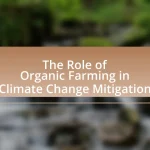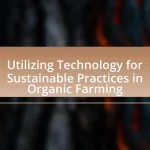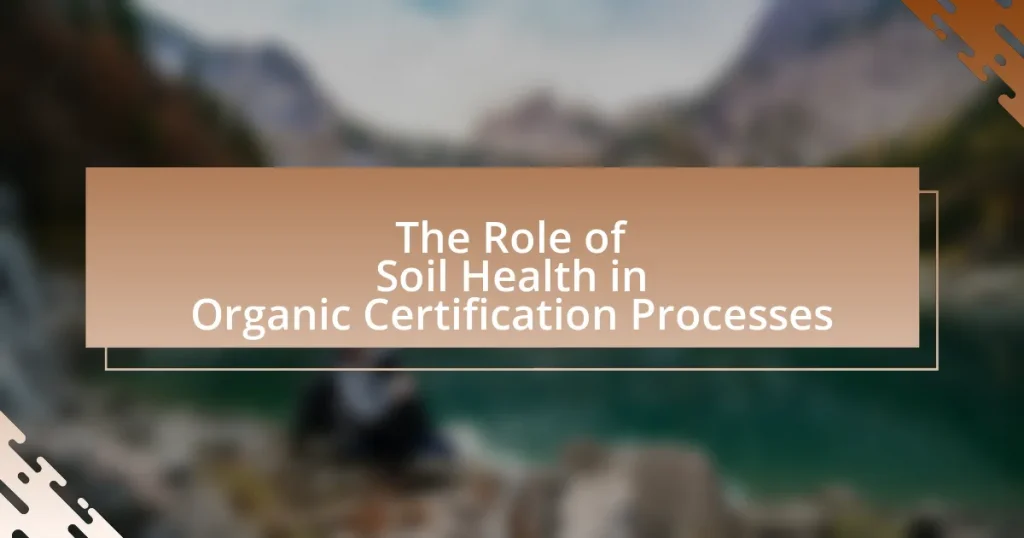Soil health is a fundamental aspect of organic certification processes, significantly impacting the sustainability and productivity of organic farming. It is defined as the soil’s capacity to function as a living ecosystem that supports plants, animals, and humans, with key indicators including soil organic matter, structure, nutrient availability, microbial activity, and pH levels. Practices such as crop rotation, cover cropping, and composting are essential for enhancing soil health and meeting organic certification standards set by organizations like the USDA. Healthy soils not only improve crop quality and yield but also bolster pest and disease resistance, making soil health a critical focus for organic farmers striving for certification. The article explores the definition of soil health, its indicators, the relationship with organic certification standards, and the challenges and best practices for maintaining soil health in organic farming.

What is the role of soil health in organic certification processes?
Soil health is a critical factor in organic certification processes as it directly influences the sustainability and productivity of organic farming systems. Healthy soil enhances nutrient availability, promotes biodiversity, and improves water retention, which are essential for growing organic crops without synthetic fertilizers or pesticides. The USDA National Organic Program mandates that organic farmers maintain or improve soil health through practices such as crop rotation, cover cropping, and organic amendments. These practices not only comply with certification standards but also contribute to long-term soil fertility and ecosystem health, ensuring that organic farming remains viable and environmentally responsible.
How is soil health defined in the context of organic farming?
Soil health in the context of organic farming is defined as the capacity of soil to function as a living ecosystem that sustains plants, animals, and humans. This definition emphasizes the importance of biological activity, nutrient cycling, and soil structure, which are critical for maintaining productivity and environmental quality. Research indicates that healthy soils are rich in organic matter, support diverse microbial communities, and have good water retention and aeration properties, all of which contribute to sustainable agricultural practices and compliance with organic certification standards.
What are the key indicators of soil health?
The key indicators of soil health include soil organic matter, soil structure, nutrient availability, microbial activity, and pH levels. Soil organic matter is crucial as it enhances soil fertility and water retention, while soil structure affects aeration and root penetration. Nutrient availability, particularly nitrogen, phosphorus, and potassium, is essential for plant growth. Microbial activity indicates biological health, as diverse microbial communities contribute to nutrient cycling and organic matter decomposition. Lastly, pH levels influence nutrient solubility and microbial activity, with most crops thriving in a pH range of 6 to 7. These indicators collectively provide a comprehensive assessment of soil health, essential for sustainable agricultural practices.
How do these indicators relate to organic certification standards?
Indicators of soil health, such as organic matter content, microbial activity, and nutrient availability, directly relate to organic certification standards by ensuring that agricultural practices promote ecological balance and sustainability. Organic certification standards, established by organizations like the USDA, require that soil management practices enhance soil fertility and biodiversity, which are reflected in these indicators. For instance, high organic matter content improves soil structure and nutrient retention, aligning with the organic principle of enhancing soil health. Additionally, microbial activity is crucial for nutrient cycling, which is essential for maintaining the ecosystem’s integrity as mandated by organic standards. Thus, these indicators serve as measurable criteria to assess compliance with organic certification requirements, ensuring that farming practices contribute positively to soil health and environmental sustainability.
Why is soil health critical for organic certification?
Soil health is critical for organic certification because it directly influences the ability to produce crops that meet organic standards. Healthy soil supports biodiversity, enhances nutrient cycling, and improves water retention, all of which are essential for sustainable agricultural practices. According to the USDA National Organic Program, organic certification requires that soil management practices promote ecological balance and biodiversity, which are foundational to maintaining soil health. Furthermore, research published in the journal “Agriculture, Ecosystems & Environment” indicates that healthy soils lead to increased crop yields and resilience against pests and diseases, reinforcing the importance of soil health in achieving organic certification.
What impact does soil health have on crop quality and yield?
Soil health significantly impacts crop quality and yield by influencing nutrient availability, water retention, and microbial activity. Healthy soil promotes optimal plant growth by providing essential nutrients and improving root development, which directly correlates with higher crop yields. Research indicates that soils with high organic matter content can increase crop yields by 20-30% compared to degraded soils, as they retain moisture better and support diverse microbial communities that enhance nutrient cycling. Additionally, studies show that healthy soils lead to improved crop quality, including better taste and nutritional value, due to the balanced nutrient supply and reduced stress on plants.
How does soil health influence pest and disease resistance?
Soil health significantly influences pest and disease resistance by promoting a diverse and balanced ecosystem that supports beneficial organisms. Healthy soil, characterized by high organic matter, proper pH, and adequate nutrient levels, fosters the growth of plants that are more resilient to pests and diseases. Research indicates that soils rich in microbial diversity can enhance plant health by outcompeting pathogens and providing natural pest control through predation and parasitism. For instance, a study published in the journal “Soil Biology and Biochemistry” found that increased soil microbial diversity correlates with reduced incidence of plant diseases, demonstrating that healthy soil contributes to a plant’s ability to withstand biotic stressors.
What practices enhance soil health for organic certification?
Practices that enhance soil health for organic certification include crop rotation, cover cropping, composting, and reduced tillage. Crop rotation improves soil structure and fertility by alternating different plant families, which helps break pest and disease cycles. Cover cropping adds organic matter and nutrients to the soil, while also preventing erosion and suppressing weeds. Composting enriches soil with beneficial microorganisms and nutrients, enhancing microbial activity. Reduced tillage minimizes soil disturbance, preserving soil structure and promoting biodiversity. These practices are supported by research indicating that they significantly improve soil organic matter and overall soil health, which are critical for meeting organic certification standards.
Which organic farming practices contribute to soil health improvement?
Organic farming practices that contribute to soil health improvement include crop rotation, cover cropping, composting, and reduced tillage. Crop rotation enhances soil structure and fertility by alternating different crops, which helps break pest and disease cycles. Cover cropping prevents soil erosion, improves organic matter, and enhances nutrient cycling by planting crops during off-seasons. Composting adds essential nutrients and beneficial microorganisms to the soil, promoting microbial diversity and soil structure. Reduced tillage minimizes soil disturbance, preserving soil structure and enhancing water retention. These practices collectively improve soil health, which is crucial for sustainable organic farming and is a key component of organic certification processes.
How can cover cropping and crop rotation benefit soil health?
Cover cropping and crop rotation significantly enhance soil health by improving soil structure, increasing organic matter, and promoting biodiversity. Cover crops, such as legumes, fix nitrogen in the soil, which reduces the need for synthetic fertilizers and enhances nutrient availability. Crop rotation disrupts pest and disease cycles, reducing reliance on chemical pesticides and fostering a more resilient soil ecosystem. Research indicates that these practices can increase soil organic carbon levels by up to 30%, leading to improved soil fertility and water retention, which are critical for sustainable agriculture.
How does soil health assessment fit into the organic certification process?
Soil health assessment is a critical component of the organic certification process, as it evaluates the biological, chemical, and physical properties of soil that contribute to sustainable agricultural practices. Organic certification standards, such as those set by the USDA National Organic Program, require farmers to maintain or improve soil health through practices that enhance soil fertility and biodiversity. For instance, practices like crop rotation, cover cropping, and reduced tillage are encouraged to promote soil health, which in turn supports the overall ecosystem and reduces reliance on synthetic inputs. The assessment of soil health provides measurable indicators that demonstrate compliance with these organic standards, ensuring that the farming practices align with the principles of organic agriculture.
What challenges do farmers face in maintaining soil health for certification?
Farmers face several challenges in maintaining soil health for certification, including nutrient depletion, soil erosion, and pest management. Nutrient depletion occurs when crops are harvested without adequate replenishment of essential minerals, leading to reduced soil fertility. Soil erosion, often exacerbated by poor land management practices, can strip away the topsoil, which is crucial for plant growth and microbial activity. Additionally, managing pests organically can be difficult, as farmers must find effective methods that do not compromise soil health or violate certification standards. These challenges are compounded by the need for continuous monitoring and adherence to organic practices, which can be resource-intensive and require specialized knowledge.
How can farmers overcome these challenges?
Farmers can overcome challenges related to soil health in organic certification processes by implementing sustainable agricultural practices. These practices include crop rotation, cover cropping, and reduced tillage, which enhance soil structure and fertility. Research indicates that crop rotation can increase soil organic matter by up to 30%, improving nutrient availability and microbial activity. Additionally, using organic amendments such as compost can further enrich soil health, leading to better crop yields and compliance with organic standards. By adopting these methods, farmers can effectively address soil health issues and meet the requirements for organic certification.
What are the best practices for ensuring soil health in organic farming?
The best practices for ensuring soil health in organic farming include crop rotation, cover cropping, composting, and reduced tillage. Crop rotation enhances soil fertility and disrupts pest cycles, while cover cropping prevents erosion and improves soil structure. Composting adds organic matter and nutrients, fostering microbial activity essential for soil health. Reduced tillage minimizes soil disturbance, preserving soil structure and biodiversity. Research indicates that these practices contribute to improved soil organic matter levels, nutrient cycling, and overall ecosystem resilience, which are critical for meeting organic certification standards.
How can farmers monitor and evaluate soil health effectively?
Farmers can monitor and evaluate soil health effectively by utilizing soil testing, observing plant growth, and implementing cover cropping. Soil testing provides quantitative data on nutrient levels, pH, and organic matter content, which are essential for assessing soil fertility and structure. Regular testing, recommended every 2-3 years, allows farmers to track changes over time and make informed decisions about amendments. Observing plant growth, including root development and crop yield, offers qualitative insights into soil health, as healthy soils support robust plant growth. Additionally, implementing cover cropping enhances soil structure, reduces erosion, and increases organic matter, contributing to overall soil health. Research indicates that these practices lead to improved soil quality and productivity, essential for meeting organic certification standards.
What resources are available for farmers seeking to improve soil health?
Farmers seeking to improve soil health can access a variety of resources, including government programs, educational materials, and soil health assessment tools. The USDA Natural Resources Conservation Service offers technical assistance and financial incentives through programs like the Environmental Quality Incentives Program, which supports practices that enhance soil health. Additionally, universities and agricultural extension services provide research-based information and workshops on soil management practices. Soil health assessment tools, such as the Soil Health Card and the Haney Soil Test, help farmers evaluate soil conditions and implement appropriate amendments. These resources collectively support farmers in adopting sustainable practices that improve soil health, which is crucial for organic certification processes.










